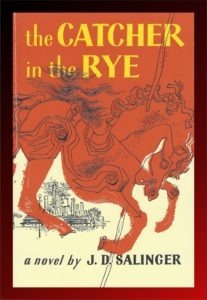Salinger Explores Self and Grief

Jerome David Salinger. 1945. The Catcher in the Rye. New York: Little, Black, and Company—Back Bay Books.
Review by Stephen W. Hiemstra
An adage among those who listen carefully to people states that one cannot help but tell their own story. For example, Savage (77) writes:
“Everyone tells stories—children, youth, and adults of all ages. Hidden inside those stories, like diamonds in the rough, are the deep truths of the unconscious. Storytelling is a form of self-disclosure.”
Especially obvious are stories that begin—I know a man who—which almost always are stories about the one telling the story (Savage 95). Fiction stories are, of course, no different.
In his book, The Catcher in the Rye, J.D. Salinger introduced us to a moody young man, Holden Caulfield, who is about to be kicked out of a boarding school, Pencey Preparatory, not too far from New York City. When we drop in on Holden, it is the last weekend before school lets out in December and he narrates his interactions with roommates and professors, but something is not right. His roommate pressures him into writing a composition for him, arguing that he is too busy with his love interest to write the report, which makes no sense if Holden is flunking out because of a lack of academic ability. His professor feels guilty for flunking him, which makes no sense if Holden is flunking out because he just doesn’t fit in. When we learn that Holden is a junior and has flunked out of three other schools, we begin to wonder why exactly Holden just cannot make a go of it at Pencey.
Holden is due to return home for the holidays on Wednesday, but gets bored and anxious saying goodbye to friends and faculty at Pencey so he takes the train into New York City and, rather than good home, rents a room in a cheap flop house. Riding the elevator up to his room, the elevator operator offers to hook him up with a prostitute. He agrees, checks into his room, and waits for his date. As he is waiting, he notices that the hotel across the street is a source of immediate entertainment, as people have left their blinds up and are engaging in all sorts of mischief. In particular, he witnesses a man dressing up in women’s clothes and a couple having fun squirting their drinks all over each other.
Meanwhile, his date shows up and begins undressing only to find Holden not in the mood for sex, but quite willing to pay for her company. The prostitute gets bored and asks for her money, at which point Holden learns that the price he was quoted was not the price now being asked. He refuses to pay the additional cost and, when the girl leaves only to come back with her pimp, he ends up getting beat up in an odd display of principle, because he has repeatedly shared with us as readers that he lacks courage. Even odder is that in the middle of his beating he never tells the pimp that the prostitute did not earn her wages.
In telling the story about his experience with the prostitute, we learn that Holden cannot stand the idea of making love to anyone without actually being in love with them—Holden is not as loose and wild as we are led to believe. But it is like we as the readers learn this important insight before Holden himself becomes aware of it. In fact, in his brooding and wandering around New York visiting bars, calling up friends, and dropping in on former professors we learn that Holden is fixated on a friend, Jane Gallagher, who he never quite gets the courage to call. Yet, he calls an old flame, Sally Hayes, and even meets with her. Holden is a young man seriously out of touch with himself.
Being out of touch with himself, Holden does not process grief well. Early in the book, we learn that Holden is still grieving the death of his brother, Allie, who died of leukemia. Late in the book we learn of the death also of a friend, James Castle, at one of the previous schools who, after being bullied by classmates, jumped out of a window to his death. The reason for the bullying is never stated, but the professor, Mr. Antolini, who retrieved the boy’s body remained a close friend of Holden even after he left that school and Holden later suspects him of being a pervert. Furthermore, Castle’s death appears to have been the source of Holden’s inability to concentrate and to complete his education. Just like the reason for the bullying remains a mystery, so does their relationship. Was Castle more than a casual friend?
AssessmentJ.D. Salinger’s The Catcher in the Rye proved to be a good read and is now, in spite of a lot of foul language and exploration of sexual themes, a book which is frequently required reading for young adults. In my case, it was a father’s day gift from my son and, as a novel, a diversion from my usual nonfiction fare. The origin of the title and the allusion posed by the cover are both revealed at the appropriate time in the narration which you might enjoy learning for yourself. I certainly did.
FootnotesSalinger admitted as much in an interview in 1953 (https://en.wikipedia.org/wiki/J._D._S...).
ReferencesSavage, John. 1996. Listening and Caring Skills: A Guide for Groups and Leaders. Nashville: Abingdon Press.
Salinger Explores Self and GriefAlso see:Niebuhr Examines American Christian Roots, Part 1 Friedman Brings Healing by Shifting Focus from Individuals to the Family Books, Films, and MinistryOther ways to engage online:Author site: http://www.StephenWHiemstra.netPublisher site: http://www.T2Pneuma.com Newsletter at: https://bit.ly/Adv_2024, Signup
The post Salinger Explores Self and Grief appeared first on T2Pneuma.net.



